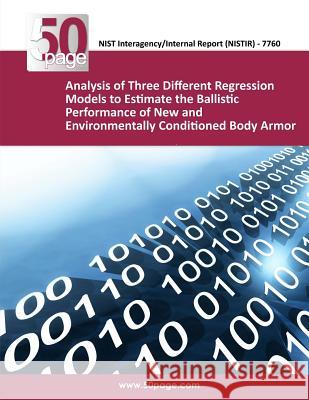Analysis of Three Different Regression Models to Estimate the Ballistic Performance of New and Environmentally Conditioned Body Armor » książka
Analysis of Three Different Regression Models to Estimate the Ballistic Performance of New and Environmentally Conditioned Body Armor
ISBN-13: 9781493755929 / Angielski / Miękka / 2013 / 54 str.
Analysis of Three Different Regression Models to Estimate the Ballistic Performance of New and Environmentally Conditioned Body Armor
ISBN-13: 9781493755929 / Angielski / Miękka / 2013 / 54 str.
(netto: 45,57 VAT: 5%)
Najniższa cena z 30 dni: 47,72
ok. 16-18 dni roboczych
Dostawa w 2026 r.
Darmowa dostawa!
The performance standard for ballistic-resistant body armor published by the National Institute of Justice (NIJ), NIJ Standard 0101.06, recommends estimating the perforation performance of body armor by performing a statistical analysis on V50 ballistic limit testing data. The logistic regression model is the statistical regression model recommended in the NIJ standard, but depending on the armor system and the amount of ballistic data collected for that system, other regression models may be more appropriate. Thus, the first objective of this study is to evaluate and compare the estimations of the performance provided by different statistical methods applied to ballistic data generated in the laboratory. Three different distribution models that are able to describe the relationship between the projectile velocity and the probability of perforation are considered: the logistic, the probit and the complementary log-log response models. In this work, each regression model will be discussed and applied to the ballistic limit data, using the method of maximum likelihood to estimate regression parameters. Then the model estimation results will be compared and evaluated. Different criteria for assessing the goodness of fit for each model will be investigated to identify criteria that can best distinguish which regression method produces the most accurate estimate of the performance of a particular armor model and to understand how an armor model s performance changes as it ages, either through field or laboratory aging. A secondary objective of this study is to apply the different methods to a new body armor model with unusual ballistic limit results, leading one to suspect that it may not be best described by a symmetric model, to determine if this data can be better fitted by a model other than the logistic model.
Zawartość książki może nie spełniać oczekiwań – reklamacje nie obejmują treści, która mogła nie być redakcyjnie ani merytorycznie opracowana.











